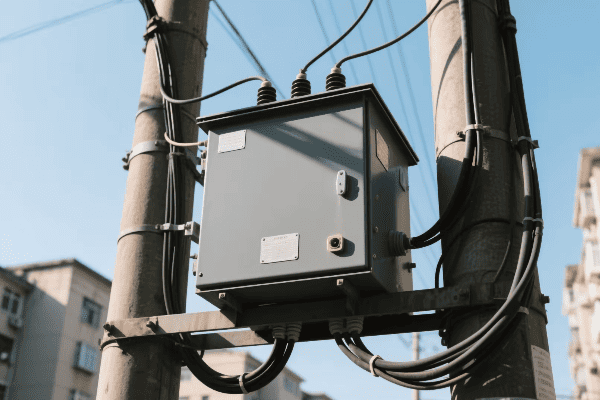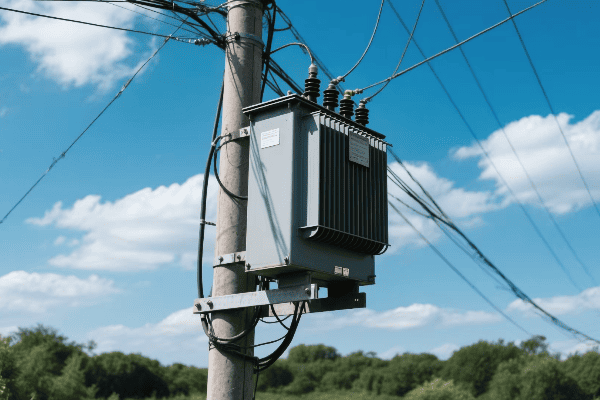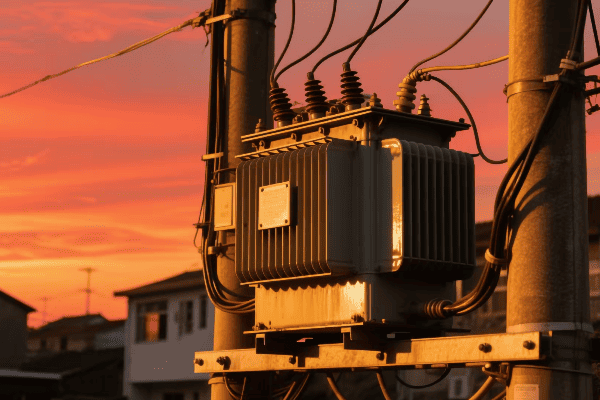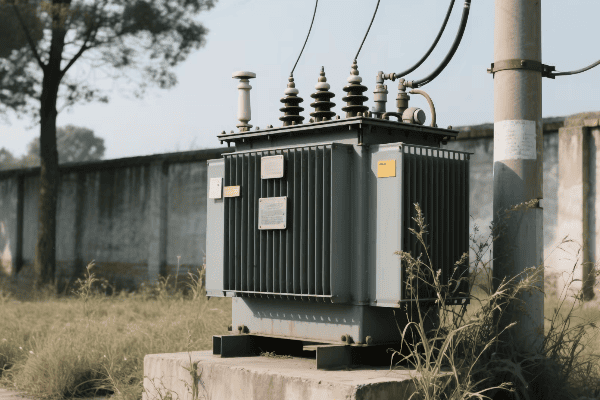Large Power Transformer: Essential Components of Modern Electrical Grids?
Have you ever wondered how electricity travels across vast distances? The answer lies in large power transformers, but many people don’t know their importance.
Large power transformers are critical components in electrical grids. They enable efficient long-distance power transmission by stepping up voltage for transmission and stepping it down for distribution. These transformers are essential for maintaining grid stability and reliability.

In this article, I’ll share my insights on large power transformers. I’ve worked with these giants for years, and I’m excited to explain their role in our power systems.
What Defines a Large Power Transformer and Its Unique Characteristics?
When I first saw a large power transformer, I was amazed by its size. These aren’t your typical transformers you see on utility poles.
Large power transformers are defined by their high capacity, typically above 100 MVA, and their ability to handle extra high voltages, often 345 kV and above. They are massive, custom-built machines designed for specific grid locations and requirements.

Let’s dive deeper into what makes large power transformers unique:
Size and Capacity
Large power transformers are truly massive:
- Physical Size: They can be as large as a house and weigh hundreds of tons.
- Capacity: Typically range from 100 MVA to over 1,000 MVA.
- Voltage Levels: Can handle voltages from 345 kV to 765 kV or even higher.
I once worked on a project installing a 500 MVA transformer. The logistics of transporting and installing such a massive piece of equipment were incredibly complex.
Custom Design
Unlike smaller transformers, large power transformers are not off-the-shelf products:
| Aspect | Description |
|---|---|
| Design | Tailored to specific grid location and requirements |
| Manufacturing | Built to order, often taking months to produce |
| Installation | Requires specialized equipment and expertise |
Each large power transformer is unique. I remember a project where we had to design a transformer to fit in a tight substation space while meeting specific performance requirements. It was like solving a complex puzzle.
Cooling Systems
Large power transformers require advanced cooling systems:
- Oil Cooling: Most use mineral oil for insulation and cooling.
- Forced Oil and Air Cooling: Fans and pumps circulate oil and air.
- Water Cooling: Some use water-cooled radiators for additional cooling.
The cooling system design is crucial. I once worked on optimizing a cooling system for a transformer in a hot climate. We had to ensure it could handle peak loads even on the hottest days.
On-Load Tap Changers
Large power transformers often include sophisticated on-load tap changers:
- Function: Adjust voltage ratios without interrupting power flow.
- Complexity: More complex than those in smaller transformers.
- Importance: Critical for maintaining grid voltage stability.
I’ve seen how crucial these tap changers are. In one project, we implemented an advanced tap changer control system that significantly improved voltage regulation across a large service area.
How Do Large Power Transformers Contribute to Efficient Energy Transmission in Electrical Grids?
Efficient energy transmission is crucial for our power grids. Large power transformers play a key role in this process. I’ve seen firsthand how these transformers can make or break a grid’s efficiency.
Large power transformers enable efficient energy transmission by stepping up voltage for long-distance power transfer. This reduces transmission losses and allows for bulk power transfer across great distances. They also step down voltage at substations for local distribution.

Let’s explore how large power transformers contribute to efficient energy transmission:
Voltage Step-Up for Transmission
Large power transformers at power plants step up voltage for transmission:
- Typical Step-Up: From generator voltage (15-25 kV) to transmission voltage (345-765 kV).
- Purpose: Higher voltage means lower current for the same power, reducing losses.
- Efficiency: Enables power transfer over hundreds of miles with minimal losses.
I once worked on a project upgrading a power plant’s main step-up transformer. The new transformer increased the plant’s transmission capacity by 20%, allowing it to serve a larger area more efficiently.
Voltage Step-Down for Distribution
At substations, large transformers step down voltage for distribution:
| Input Voltage | Output Voltage | Purpose |
|---|---|---|
| 345-765 kV | 115-138 kV | Subtransmission |
| 115-138 kV | 69 kV | Large industrial |
| 69 kV | 12-34.5 kV | Local distribution |
This step-down process is crucial. I’ve designed substation layouts to optimize the placement of these transformers, ensuring efficient power flow to different service areas.
Bulk Power Transfer
Large power transformers enable bulk power transfer between regions:
- Interconnections: Allow power exchange between different grid systems.
- Load Balancing: Enable power transfer from areas of excess to areas of need.
- Renewable Integration: Facilitate transfer of power from remote renewable sources.
I’ve been involved in projects connecting large wind farms to the grid. The ability to transfer bulk power over long distances was crucial for making these renewable projects viable.
Loss Reduction
Large power transformers are designed for high efficiency:
- Core Design: Advanced materials and designs minimize core losses.
- Winding Design: Optimized for minimal resistance and eddy current losses.
- Cooling Systems: Efficient cooling reduces losses due to heating.
In one project, we replaced an old transformer with a modern, high-efficiency model. The reduction in losses was significant, saving the utility millions in energy costs over the transformer’s lifetime.
What Are the Critical Design Features of Large Power Transformers for Grid Stability?
Grid stability is a top priority in power system design. Large power transformers play a crucial role in maintaining this stability. I’ve spent a lot of time optimizing transformer designs for grid stability.
Critical design features of large power transformers for grid stability include robust mechanical construction, advanced voltage regulation systems, efficient cooling mechanisms, and high short-circuit strength. These features ensure the transformer can handle system disturbances and maintain reliable operation.

Let’s explore these critical design features in detail:
Robust Mechanical Construction
Large power transformers must withstand various stresses:
- Short-Circuit Forces: Massive electromagnetic forces during faults.
- Seismic Activity: Must remain operational even during earthquakes.
- Transportation Stresses: Designed to handle shocks during transport and installation.
I once worked on a transformer design for a seismically active area. We had to use advanced 3D modeling to ensure the transformer could withstand potential earthquakes without losing its alignment or functionality.
Advanced Voltage Regulation
Voltage regulation is crucial for grid stability:
| Feature | Function | Benefit |
|---|---|---|
| On-Load Tap Changers | Adjust voltage ratio during operation | Maintain stable output voltage |
| Automatic Voltage Control | Respond to grid voltage fluctuations | Prevent voltage sags or swells |
| Fast Response Time | Quick adjustment to sudden load changes | Improve transient stability |
I’ve implemented advanced voltage control systems that can respond to grid fluctuations in milliseconds. This rapid response is crucial for maintaining stability, especially with the increasing integration of intermittent renewable sources.
Efficient Cooling Mechanisms
Proper cooling is essential for stable operation:
- Oil Directed/Oil Forced (ODOF): Pumps circulate oil through cooling radiators.
- Oil Directed/Air Forced (ODAF): Fans enhance cooling of oil radiators.
- Water-Cooled Systems: For very large transformers or special applications.
I remember a project where we had to design a cooling system for a transformer in an extremely hot climate. We ended up using a combination of ODAF and water cooling to ensure the transformer could handle peak loads even on the hottest days.
High Short-Circuit Strength
Transformers must withstand short-circuit events:
- Winding Design: Special bracing and supports to handle electromagnetic forces.
- Insulation System: Designed to withstand electrical and mechanical stresses.
- Core Construction: Robust core clamping to prevent movement during faults.
I’ve been involved in transformer failure investigations where inadequate short-circuit strength was the root cause. These experiences have taught me the importance of rigorous design and testing in this area.
Impedance Control
Transformer impedance affects system stability:
- Impedance Matching: Designed to match system requirements.
- Parallel Operation: Impedance affects load sharing between transformers.
- Fault Current Limitation: Higher impedance can help limit fault currents.
Choosing the right impedance is a balancing act. I’ve worked on projects where we had to carefully select transformer impedances to ensure stable parallel operation of multiple units while also considering fault current levels.
How Are Large Power Transformers Integrated into Smart Grid Technologies?
Smart grid technologies are revolutionizing our power systems. Large power transformers are being adapted to fit into this new, intelligent grid. I’ve been involved in several projects integrating these transformers with smart grid systems.
Large power transformers are integrated into smart grid technologies through advanced monitoring systems, real-time data analytics, and automated control mechanisms. This integration allows for improved asset management, predictive maintenance, and dynamic grid optimization.

Let’s explore how large power transformers are becoming part of the smart grid:
Advanced Monitoring Systems
Modern large power transformers are equipped with various sensors:
- Temperature Sensors: Monitor oil and winding temperatures.
- Dissolved Gas Analysis (DGA): Detect fault gases in transformer oil.
- Partial Discharge Monitoring: Identify insulation weaknesses.
- Load Tap Changer Monitoring: Track tap changer performance.
I once worked on implementing a comprehensive monitoring system for a fleet of large transformers. The amount of data we could collect was impressive, giving us insights we never had before.
Real-Time Data Analytics
Smart grid integration involves processing transformer data in real-time:
| Data Type | Analysis | Benefit |
|---|---|---|
| Temperature Data | Thermal modeling | Optimize loading and cooling |
| DGA Data | Fault gas trend analysis | Early fault detection |
| Tap Changer Data | Operation pattern analysis | Predict maintenance needs |
| Loading Data | Dynamic rating calculation | Maximize transformer capacity |
I’ve seen how real-time analytics can make a difference. In one project, we were able to detect a developing fault months before it would have caused a failure, saving millions in potential outage costs.
Automated Control Mechanisms
Smart grids allow for automated transformer control:
- Dynamic Voltage Regulation: Automatic adjustment based on grid conditions.
- Cooling System Optimization: Intelligent control of cooling based on load and ambient conditions.
- Load Management: Coordinated control of multiple transformers for optimal power flow.
I’ve implemented automated control systems that can balance loads across multiple transformers in a substation, significantly improving overall efficiency and reliability.
Integration with SCADA Systems
Large transformers are integrated into broader grid management systems:
- Data Reporting: Regular status updates to control centers.
- Remote Control: Ability to adjust transformer settings from afar.
- Alarm Systems: Immediate notification of abnormal conditions.
I remember a project where we integrated transformer controls with a utility’s SCADA system. It gave operators unprecedented visibility and control over their transmission assets.
Cybersecurity Considerations
With increased connectivity comes the need for robust cybersecurity:
- Secure Communication Protocols: Encrypted data transmission.
- Access Control: Strict authentication for remote access.
- Regular Security Audits: Ensure ongoing protection against evolving threats.
Cybersecurity is a growing concern. I’ve worked on implementing secure communication systems for transformer monitoring, ensuring that the benefits of connectivity don’t come at the cost of vulnerability.
What Challenges and Solutions Exist in Maintaining Large Power Transformers for Grid Reliability?
Maintaining large power transformers is crucial for grid reliability. These massive machines face unique challenges. I’ve encountered many of these challenges in my career and worked on innovative solutions.
Challenges in maintaining large power transformers include aging infrastructure, increasing load demands, and the need for predictive maintenance. Solutions involve advanced monitoring technologies, life extension techniques, and strategic replacement planning to ensure continued grid reliability.

Let’s dive into the challenges and solutions for maintaining large power transformers:
Aging Infrastructure
Many large transformers are nearing the end of their designed life:
- Challenge: Increased risk of failure as transformers age.
- Solution: Life extension programs and condition-based maintenance.
I’ve worked on life extension projects for transformers over 40 years old. With proper maintenance and upgrades, we’ve been able to safely extend their service life by 15-20 years.
Increasing Load Demands
Modern grids often push transformers to their limits:
| Challenge | Solution | Benefits |
|---|---|---|
| Higher load stress | Dynamic rating systems | Maximize capacity safely |
| Overloading risks | Advanced cooling upgrades | Increase short-term overload capability |
| Harmonics from non-linear loads | Harmonic mitigation techniques | Reduce heating and extend life |
I once implemented a dynamic rating system for a critical transformer. It allowed the utility to safely increase its capacity by 15% during peak demand periods.
Predictive Maintenance
Moving from time-based to condition-based maintenance:
- Challenge: Predicting failures before they occur.
- Solution: Advanced monitoring and AI-based predictive analytics.
I’ve been involved in developing AI models that can predict transformer faults weeks or even months in advance. It’s amazing how much we can learn from the data these transformers generate.
Oil Management
Oil is crucial for insulation and cooling:
- Challenge: Oil degradation over time.
- Solution: Regular oil testing and advanced oil regeneration techniques.
I remember a project where we implemented an online oil purification system. It continuously cleaned the transformer oil, significantly extending the transformer’s life and improving its reliability.
Spare Part Management
Many large transformers are custom-built:
- Challenge: Long lead times for replacement parts.
- Solution: Strategic spare part inventory and 3D printing for certain components.
I’ve worked with utilities to develop spare part strategies. In one case, we used 3D printing to quickly produce a custom bushing adapter, avoiding a lengthy outage.
Environmental Concerns
Transformers can pose environmental risks:
- Challenge: Oil leaks and PCB contamination in older units.
- Solution: Containment systems and environmentally friendly insulating fluids.
I’ve been involved in projects replacing old oil with biodegradable ester fluids. It’s a great way to reduce environmental risk while also improving transformer cooling.
Workforce Expertise
Specialized knowledge is required for transformer maintenance:
- Challenge: Retiring workforce with years of experience.
- Solution: Knowledge transfer programs and augmented reality maintenance tools.
I’ve helped develop training programs using VR and AR technologies. These tools help new technicians gain experience safely and efficiently.
Conclusion
Large power transformers are critical for grid stability and efficiency. Understanding their design, integration with smart grids, and maintenance challenges is crucial for ensuring reliable power supply. Continuous innovation in this field is essential for our evolving energy needs.
Free CHBEB Transformer Catalog Download
Get the full range of CHBEB transformers in one catalog.
Includes oil-immersed, dry-type, pad-mounted, and custom solutions.
Quick Message
Request A free quote
We'd like to work with you
- +86 15558785111
- [email protected]
- +86 15558785111
What We Do
CHINA BEI ER BIAN (CHBEB) GROUP, with 218 million in registered capital, originated from Beijing Beierbian Transformer Group. Headquartered in Beijing for R&D, it operates major production bases in Nanjing and Yueqing, producing high-quality products.
Latest Product
address
BeiJing
No 3,RongJing East Road,BeiJing Economic Technological Development Area,BeiJing,China
JiangSu
No 7️Xiangfeng Road,Jiangning,NanJing,JiangSu,China
WenZhou
No.211, Wei 16 Road, Industrial Zone, Yueqing, Wenzhou, Zhejiang, China.
XiangYang Industrial Zone ,YueQing,WenZhou,ZheJiang,China
contact us
- [email protected]
- +86 13057780111
- +86 13057780111
- +86 15558785111
Copyright © Bei Er Bian Group


